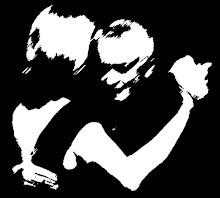What is
comme il faut? No, it’s not the shoes!
The literal translation from the French (according to our French-English dictionary) is "How Things Are Done," but that doesn't begin to describe it.
It's about manners, and behaving properly in polite society, and keeping your cool under provocation (both verbal and physical).
It's behaving like a lady, or acting like a gentleman.
It's that very rare quality in today's self-promoting, blame-shifting, tell-all society known as class.
When we named our new milonga
Comme il faut just 4 years ago, it was very much a case of our belief in “how a milonga should be”. From spending a month in Buenos Aires every year since 1999, we have come to embrace the style of milonga that we believe to be typical of the ‘Mecca of tango’.
We wanted to cultivate some of the important elements that we value at the more traditional milongas in BsAs. Many hours spent in Maipu 444 watching and dancing, while absorbing the music of master DJ Carlos Rey, have provided a thorough education in what makes a successful milonga.
Consequently, we chose a venue which has character – a 1920s golf club – with a relatively small salon, accommodating around 55 people. With the tables arranged tightly around the dance floor, those who watching are always in close contact with those who are dancing. It also makes possible and encourages the use of the
cabeceo. The size of the dance floor requires dancers to have good navigation skills, respect the line of dance, and dance appropriately. So it follows that elaborate performance figures and activities that disturb other dancers (eg. high
boleos) are not welcome …… and we haven’t been shy in asking ladies to keep their heels close to the floor. We are delighted that there seems to be an understanding that good floor-craft and care for other dancers are the norms at
Comme il faut.
The other guiding influence is has been the DJ culture of Buenos Aires. Pat’s music is largely the best of the Golden Age, with playlists influenced by the likes of Carlos Rey, Mario Orlando, and Dany Borelli. Persistence with this wonderful music at
Comme il faut, has meant that local dancers are now saying that they have come to love the music of that period.
So why do we, in Australia, want to promote a
milonga modeled on our favourites in Buenos Aires? For a start, it’s what we love, and we want to share what we believe is a genuine tango experience with local dancers. There’s also the reality that many dancers of all abilities are holidaying in Buenos Aires, with the intention of dancing tango there. What we offer is a snapshot of what to expect. As a result, dancers may recognize the changes they may need to make to their current style of dancing in order to fit in. After all, many
milongas in BsAs are much more crowded than here. Good navigation skills are essential.
Sacadas, volcadas, &
colgadas are rarities in the traditional
milongas. Better to learn this before arriving in BsAs than experiencing a rude shock.
Should all
milongas be modeled on the traditional BsAs ones? Well, if they were, we would love every minute of them. However, other people insist that home-grown
milongas should not try to copy BsAs, but have their own local style. What do you think?
Bob.




